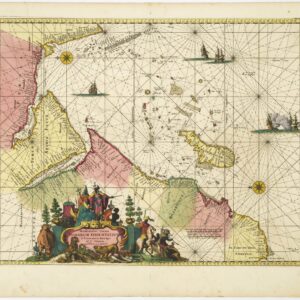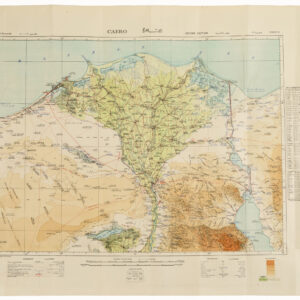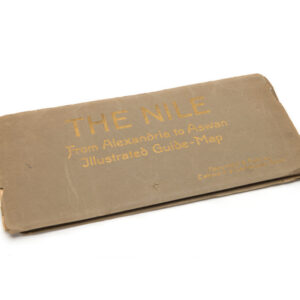World War II German relief map of Africa for the blind, with Arabia and the Middle East.
[Map for the Blind] Afrika…Hergestellt im Lehrmittel-Verlag der Marburger Blindenstudienanstalt
Out of stock
Description
A map of Africa on two separate sheets of thick paper prepared to be used by the blind with embossed topography; striated embossed lines representing the ocean; raised, dotted lines representing political borders; raised lines for rivers; and embossed braille letters for toponyms. The map has been hand-annotated by a contemporary hand in ink so that all of the features are legible to the sighted as well as the blind.
The map was created in 1941, in the same year that the German Afrika Korps — commanded by Erwin Rommel, who later became known as “The Desert Fox” — was dispatched to North Africa. The North African campaign of the Second World War lasted from 1940 to 13 May 1943, and included campaigns fought in the Libyan and Egyptian deserts, Morocco, Algeria, and Tunisia.
Likely as a result of interest in the theater of operations for the North Africa campaign, the geography presented on the map is especially detailed there. This includes mountains, wadis, oases, and even the important Schotts of southern Tunisia — the salt marshes which influenced the placement of defensive lines.
The map extends east to include most of Arabia and the Persian Gulf, great cities of Iran, Baghdad and the Tigris and Euphrates River, much of the Levant, as well as Cyprus and Crete. Most of the toponyms are denoted by one or two braille letters.
According to the title block, the map was prepared by Lehrmittel-Verlag for the Marburger Blindenstudienanstall (the Marburg Institute for the Blind), which was then and is now the national institute for the blind in Germany:
During the First World War, many young men with visual impairments or total blindness returned home. Due to their disability, many were no longer able to work. The then director of the Marburg University Eye Clinic, Alfred Bielschowsky, set up courses in 1915 to provide the blind for the blind with access to aids and the learning of blind techniques. He commissioned the then student Carl Strehl to lead the courses. Together they founded the Association of Blind Academics of Germany and made contact with personalities of the Prussian state to promote funds and support.
First of all, the integration of the blind into working life and finishing school was the primary goal of the institution. In 1921, the grammar school was officially recognized. In order to provide young blind people with a qualified education and training, special learning and teaching materials were needed, which were provided by the emerging Braille printer and the library.
Overall, this is a wonderful cartographic creation. Closing one’s eye and following the route of the Nile and Niger rivers, or the distinct relief of the Red Sea and the Hijazi Mountains, allows for a new appreciation of the rich topography of the region.
Cartographer(s):
Condition Description
Very good; see image.
References


![[3-Sheet Biodiversity Map of Madagascar] Carte Internationale du Tapis Végétal et des Conditions Écologiques.](https://neatlinemaps.com/wp-content/uploads/2024/05/NL-01035-middle_thumbnail-300x300.jpg)
